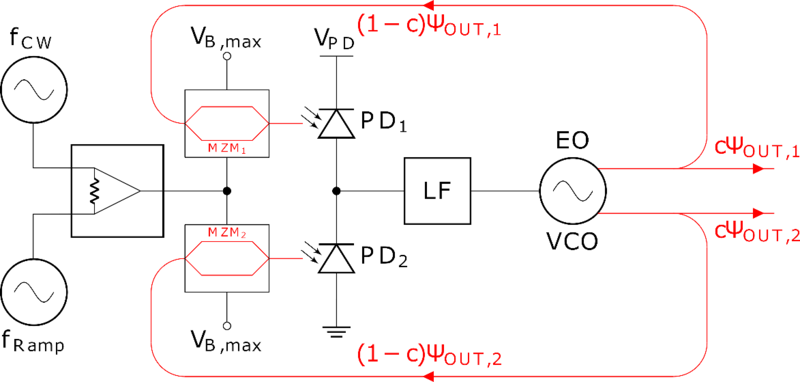Summary
- Profile Type
- Technology offer
- POD Reference
- TODE20230913015
- Term of Validity
- 13 September 2023 - 12 September 2025
- Company's Country
- Germany
- Type of partnership
- Research and development cooperation agreement
- Investment agreement
- Targeted Countries
- All countries
Contact the EEN partner nearest to you for more information.
Find my local partner
General information
- Short Summary
- A German university developed a new electro-optical PLL (phase-locked loops) circuit that allows a radio channel to be used with maximum efficiency. The electro-optical PLL is particularly well suited for radar systems with optical clock distribution and for radio-over-fiber (RoF) systems that require optical signals with the narrowest possible spectral characteristics. The university offers a license and a technology cooperation agreement.
- Full Description
-
To generate frequencies for communication or measurement and control technology, demodulate frequency- or phase-modulated signals, or synchronize or recapture a frequency, phase-locked loops, or PLLs, are used.
The new electro-optical PLL circuit from a German university generates an intensity-modulated optical signal. It consists of an electrical signal source with a sinusoidal signal and one with a ramp signal, a summing amplifier, an electro-optical modulator, two photodiodes, a low-pass filter (LF), and an electro-optical oscillator that changes its frequency based on the control voltage. The sinusoidal signal and the ramp signal are added in the summing amplifier, and the received sum signal routed to an electro-optical modulator. In the electro-optical oscillator, the optical input signal is modulated with the sum signal so that the non-linear characteristic curve results in square law mixer behavior. The resulting signal is routed to photodiodes (PD1 and PD2), and then a low-pass filter removes the undesired harmonics from the photodiodes’ electrical signal, which is proportional to the difference in phase and frequency. The resulting electrical signal is used as an input signal for the electro-optical oscillator (EO), setting the electro-optical oscillator to the product of the sinusoidal signal and the ramp signal.
The electro-optical PLL is particularly well-suited to radar systems with optical clock distribution and to radio over fiber (RoF) systems that need optical signals with spectral characteristics featuring bands that are as narrow as possible so that the wireless channel can be used with maximum efficiency.
The university offers a license agreement to companies from measurement or communication technology. If there is interest in further development of the process, the university also offers technological cooperation. - Advantages and Innovations
-
The main advantages and innovative aspects of this invenation are:
- Efficient optical signal stabilization
- Generation of narrow-band optical signals
- Generation of optical FMCW ramps - Stage of Development
- Concept stage
- Sustainable Development Goals
- Goal 9: Industry, Innovation and Infrastructure
- IPR status
- IPR applied but not yet granted
- IPR notes
- A German and European patent has been applied for.
Partner Sought
- Expected Role of a Partner
-
The university offers a license agreement to companies from measurement or communication technology.
If there is interest in further development of the process, the university also offers technological cooperation. - Type and Size of Partner
- Big company
- SME <=10
- SME 11-49
- SME 50 - 249
- Other
- Type of partnership
- Research and development cooperation agreement
- Investment agreement
Dissemination
- Technology keywords
- 01006004 - Narrow Band Technologies
- 01006006 - Radar
- 01006009 - Signal Processing
- Market keywords
- 03006 - Fibre Optics
- Targeted countries
- All countries
